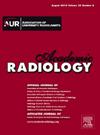对比增强计算机断层放射组学预测卵巢癌中集落刺激因子3的表达和临床预后。
IF 3.8
2区 医学
Q1 RADIOLOGY, NUCLEAR MEDICINE & MEDICAL IMAGING
引用次数: 0
摘要
目的:建立一种无创预测卵巢癌(OC)中集落刺激因子3 (CSF3)表达的放射组学模型,并评估其预后价值。材料和方法:我们从癌症基因组图谱和癌症成像档案库中获得了OC的临床数据、遗传信息和相应的计算机断层扫描(CT)。我们通过Kaplan-Meier分析、单因素和多因素Cox回归分析以及亚组分析来评估CSF3的预后意义及其与临床特征的相关性。为了探索与CSF3表达相关的潜在分子机制,我们利用基因集富集分析和免疫细胞浸润分析。特征筛选采用最大相关最小冗余和递归特征消除(RFE)算法。利用支持向量机(SVM)和logistic回归(LR)建立基于ct的放射组学预测模型。结果:CSF3在OC中表达降低,且高表达与总生存期差相关。此外,我们注意到CSF3的表达与程序性死亡配体1 (PD-L1)和唾液酸结合igg样凝集素15 (SIGLEC15)呈正相关。CSF3高表达的患者表现出肿瘤坏死因子受体超家族成员7 (CD27)表达的降低。CSF3高表达组中性粒细胞浸润增加,CD8 +T细胞减少。结论:采用LR和SVM两种方法建立的放射组学模型具有明显的临床适用性。CSF3的表达水平与OC的预后有关。基于CT的放射组学可以作为一种预测预后的新工具。本文章由计算机程序翻译,如有差异,请以英文原文为准。
Contrast-Enhanced Computed Tomography Radiomics Predicts Colony-Stimulating Factor 3 Expression and Clinical Prognosis in Ovarian Cancer
Rationale and Objectives
To develop a radiomics model for non-invasive prediction of colony-stimulating factor 3 (CSF3) expression in ovarian cancer (OC) and evaluate its prognostic value.
Materials and Methods
We acquired clinical data, genetic information, and corresponding computed tomography (CT) scans of OC from The Cancer Genome Atlas and The Cancer Imaging Archive repositories. We assessed the prognostic significance of CSF3 and its association with clinical features through the utilization of Kaplan–Meier analysis, univariate and multivariate Cox regression analysis, along with subgroup analysis. To explore the potential molecular mechanisms associated with CSF3 expression, we utilized gene set enrichment analysis and conducted an analysis on immune-cell infiltration. The max-relevance and min-redundancy and recursive feature elimination (RFE) algorithms were used for feature screening. The CT-based radiomics prediction model was built using support vector machine (SVM) and logistic regression (LR).
Results
The expression of CSF3 was found to be decreased in OC, and high expression of CSF3 was associated with poor overall survival. Moreover, it was noted that the expression of CSF3 exhibited a positive correlation with programmed death ligand 1 (PD-L1) and sialic acid-binding Ig-like lectin 15 (SIGLEC15). Patients with high CSF3 expression exhibited a decrease in tumor necrosis factor receptor superfamily member 7 (CD27) expression. The infiltration of neutrophils increased and CD8 +T cells decreased in CSF3 high expression group.
Conclusion
The radiomics model, which utilized both LR and SVM methods, demonstrated significant clinical applicability. The expression level of CSF3 was related to the prognosis of OC. Radiomics based on CT can serve as a novel tool for forecasting prognosis.
求助全文
通过发布文献求助,成功后即可免费获取论文全文。
去求助
来源期刊

Academic Radiology
医学-核医学
CiteScore
7.60
自引率
10.40%
发文量
432
审稿时长
18 days
期刊介绍:
Academic Radiology publishes original reports of clinical and laboratory investigations in diagnostic imaging, the diagnostic use of radioactive isotopes, computed tomography, positron emission tomography, magnetic resonance imaging, ultrasound, digital subtraction angiography, image-guided interventions and related techniques. It also includes brief technical reports describing original observations, techniques, and instrumental developments; state-of-the-art reports on clinical issues, new technology and other topics of current medical importance; meta-analyses; scientific studies and opinions on radiologic education; and letters to the Editor.
 求助内容:
求助内容: 应助结果提醒方式:
应助结果提醒方式:


